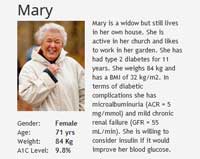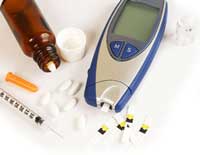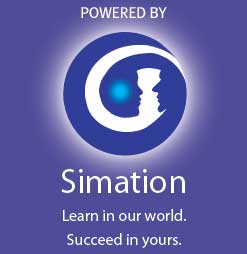Diabetes Treatment Training Through Realistic Patient Simulation
Features
Explore diagnoses safely with a virtual patient
 Learn to Treat is a self directed experience that will teach you how to better manage a variety of diabetic patients. You'll be evaluating a group of simulated patients; ordering and scheduling the appropriate medication to stabilize their condition. Along the way LTT will give you expert help and opinions which will guide you in your task. As you successfully stabilize each patient you'll be developing a useful diabetes reference library which will help you in your day to day practice. To date thousands of virtual cases have been completed.
Learn to Treat is a self directed experience that will teach you how to better manage a variety of diabetic patients. You'll be evaluating a group of simulated patients; ordering and scheduling the appropriate medication to stabilize their condition. Along the way LTT will give you expert help and opinions which will guide you in your task. As you successfully stabilize each patient you'll be developing a useful diabetes reference library which will help you in your day to day practice. To date thousands of virtual cases have been completed.
Large selection of patients types
The 19 virtual patients have been designed with your needs in mind. Each virtual patient has a specific learning objective that will help you efficiently manage the diabetic patients in your practice saving valuable practice time. Select the patient type that you'd like to practice with then review their medical history and analyze their insulin log book and determine their clinic problem. You can then determine which drug regimen to order, selecting the appropriate dose and time of day to administer. Learn to Treat will then show you how your treatment intervention affected the patient's blood glucose levels. The simulated patient may, or may not, return to your office for further treatment. Thousands of virtual cases have been completed successfully.

Learn how to initiate and intensify drug therapy

Learn to Treat has been developed as an online virtual preceptorship solution. You will be able to practice initiating therapy, learning the how to order the appropriate amount of a drug to start a patient on. Learn to Treat will also guide you in the process of intensifying therapy, particularly for insulin regimens helping you achieve optimal glycemic control for your patients in an optimal time period. Over 76% of your colleagues have indicated that they will change their clinical practice after running through this program.
Learn the latest techniques & get expert advise
Experiment, try and investigate as the simulation will let you order any combination of drug regimen. There are many correct ways to treat the virtual patients, some more optimal than others; you'll soon find out which one's work and which don't. Learn to Treat is a self-assessment exercise and you're in control of your won learning. As you move through the simulation ordering treatment for the various patients the program will provide you with hints, references and opinions from Endocrinologists. The expert's opinion will provide you with comprehensive detailing the recommended treatment protocol as well as links to medical references pertinent to each individual patient scenario. As you work through the patient scenarios you'll be building up a reference library, consisting of all the hints, expert opinion and medical literature. You can use this library to help you in your day to day practice management of your diabetic patients.
Learn how to avoid hypoglycemic and other detrimental events

Learn to Treat will teach you how to interpret a patient's Blood Glucose Patterns and identify clinical issues. The simulation will provide you with the real-time effects of pharmacological regimen interventions and they're applied to the virtual diabetic patients. You'll be able save valuable time by seeing the immediate effects of your decisions on the virtual patients A1Cs and blood glucose patterns. You'll be able to analyze the effects and try other regimens that might suit the patient clinical and lifestyle needs.
Cut learning time with immediate feedback
You'll be able to learn at your pace and in a situation that best suits you receiving instant feedback so that you can adjust your clinical approach to each case. You decide if you'd like to learn alone or if you'd like to form a study group and share the learning experience. Save time by accessing relevant virtual patient scenarios from anywhere at any time. You'll be spending an average of 30 minutes on each patient case. You can achieve a significant amount of learning in a number of short sessions. You'll be able to progress quickly through the patient scenario's learning how identify common blood glucose pattern problems and how to apply the correct agents or interventions to solve these issues. .
Simulus Algorithm Engine
Simation Medical and an international Medical Faculty have created a mathematical model that simulates human outputs, inputs and processes which create an individual's 24 hour blood glucose pattern in a Continued Glucose Monitoring System (CGMS) format. The algorithms make it possible to predict a 3 month A1C as well as daily Fasting Blood Glucose (FBG) readings. To increase the simulations precision, factors for Insulin Sensitivity and Carb Ratio as well as meal time absorption effects have also been simulated. We can therefore reproduce endogenous and exogenous glucose influences which in turn enable us to model typical diabetic patient types, as seen in primary care offices. Our simulations contain the most commonly used drugs. Simation Medical has mathematically modeled, basal and bolus insulin as well as non-insulins; such as the older sulfonylureas and newer GLP agents. The combination of these features has enabled us to provide clinical response prediction software that graphically depicts clinical outcomes for diabetic patients when lifestyle habit and pharmacology solutions are applied to typical diabetic profiles.

29 drug profiles modeled by medical experts
You can gain complete confidence by interacting with our realistic simulation algorithm engine which contains over 29 of the most commonly used drugs in North America. Simation Medical has mathematically modeled basal and bolus insulin as well as non-insulins such as the older sulfonylureas and newer GLP agents. You can learn how to use the latest class of DPP4 and GLP agents in complete safety with the knowledge that a faculty of endocrinologists across North America have helped create and test the drug algorithms.
Reacting to a multinational need
49% of your colleagues have indicated that they are uncomfortable using insulins. Simation has been asked to design and model this diabetes preceptorship by international recognized medical schools. Literature has documented that the burden of care for the diabetes pandemic is switching from secondary care institutions and Specialists to Primary Care Professionals (PCPs). It is here that clinical inertia related to insulin initiation and titration leads to suboptimal glycemic control in patients with diabetes. A combination of physiological barriers, preparedness and capacity to deal with this chronic disease has resulted in significant PCP apprehension, particularly regarding insulin. The primary cause of apprehension is related to the PCPs unfamiliarity with insulin regimens and the pharmacokinetic properties of diabetic agents. Thus insulin therapy is perceived as being challenging to initiate and intensify; the particular fear being the inducement of hypoglycemia. Learn to Treat has been developed to help PCP's identify clinical issues through Blood Glucose Pattern recognition and gain confidence using drug regimens for a range of diabetic patients.
CME accredited
This program has been accredited for a total of 19 Mainpro-C credits by The College of Family Physicians of Canada. Each case is worth 1/2 - 1 hour of continuing medical education.
Members of AAFP can also claim CME credits under a reciprocal agreement with CFPC.